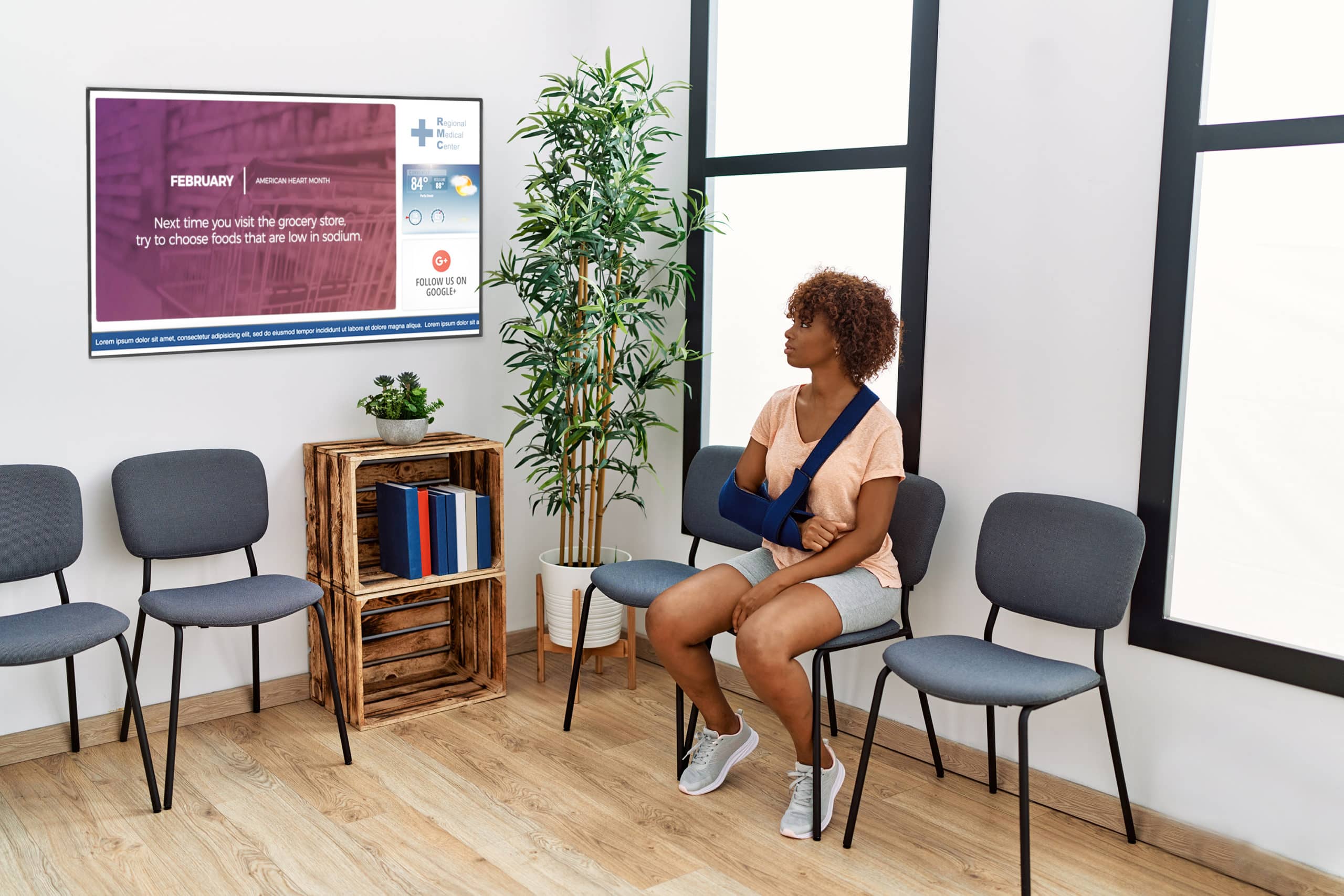
Is Your Healthcare Digital Signage Messaging Strategy Right? The Common Mistakes, And How To Avoid Them
March 12, 2024 by guest author, Rolando Irizarry
Guest Post: Rolando Irizarry, Spectrio
 Health care environments are bustling, often emotionally-charged environments that can benefit enormously from digital signage. But software and display technologies need to be paired with a solid content strategy to maximize both the investment and opportunity.
Health care environments are bustling, often emotionally-charged environments that can benefit enormously from digital signage. But software and display technologies need to be paired with a solid content strategy to maximize both the investment and opportunity.
With screens now everywhere, including on the smartphones most people now carry around, it’s essential that displays in healthcare in both the common and patient care areas of clinics, labs and hospitals all relay timely, relevant information that gets noticed – streamlining and improving patient visits and staff workflows.
Here are some of the most common mistakes made when digital signage technologies are added to medical care environments, and how they can be avoided:
No Real Content Strategy
The big question for any initiative to add screens to an environment should be about communications problems and opportunities: What is the information that the audience – the people who will see the screens – wants and needs to see, at that place and moment?
Networks too commonly launch with so much focus placed on the underlying technology – the software and display hardware – that what’s on the screens is an after-thought. In reality, the programming strategy should lead any project. What will be on the screens, the volume of material and the frequency of updates, should all directly inform technology choices.
Programming needs differ by locations and their dynamics. For example, people arriving at a busy hospital may be looking for guidance about where they are, where they then need to be, and how to get there.
However, once in patient care waiting areas, visitors are interested in their waiting status (if they are queued and assigned numbers) and in the available services, as well as the processes tied to them. Viewers can also benefit from information and assurances about medical conditions, treatments and outcomes, particularly in specialist clinics.
The kickoff meeting for planning a digital signage network should involve not only IT resources, but people from the departments that will shape and drive a content strategy.
Overlooking Staff Communications
In busy medical environments, caregiver and support staff are often on the move, all day. They’re steadily responding to shifting situations and needs. They can benefit just as much from digital signage as patients, and their friends and families.
There are two main threads for staff communications:
Situational awareness – Smart software that ties into the systems that drive everything from medical records to building automation can help provide accurate, real-time information for caregiver and supporting staff. Actionable information boosts responses in environments have relied for decades on paperwork and periodically updated dry erase marker boards. Information involves everything from need-to-know information about individual patient status to sensor and data-triggered alerts about inventory levels for mission-critical supplies.
Employee communications – Much of the staff in busy healthcare environments is deskless – on their feet for full shifts and not having the time to read emails or printed notices on breakroom message boards. Putting screens in the so-called “back of house” areas – away from public, common view – can do things like remind staff of best practices and procedures, alert them of changes, raise awareness of job or promotion opportunities, and celebrate staff or facility milestones and accomplishments.
Not Triggering Actions
As consumers, we’re conditioned to countless calls to action messages we see on TV, hear on radio and podcasts, and come across as we navigate the internet. They’re like ear-worms: Act now! Click to learn more! Call today!
The same tactic can be applied to on-screen messaging – visual nudges that shift viewers beyond awareness to actions. That can involve different reasons and take on different forms. For example:
- Targeted messaging at a cancer clinic can reinforce the benefits and availability of early detection screening programs, and encourage people to learn more;
- At a specialized clinic, screens can upsell additional services and optional treatments with the tag line: “Ask your care provider about!”
- Chronically busy waiting rooms can ease frustrations by driving awareness of “skip the line” online time window bookings and alternatives that might provide faster care.
Wrong Place And Time For Messaging
As noted earlier, the locations of screens should be characterized, with their place-specific audiences and messaging needs defined. That’s why a digital signage network may need multiple channels, with different messaging for different channels.
While there may be content that’s common across every screen on a network, the operational messaging that’s seen by staff may not be relevant to patients and visitors in common areas. What’s on those screens might also, in some way, include sensitive patient health information.
Conversely, much of what’s shown in those waiting and common areas will be overly familiar to staff, and offer no new benefit to that audience.
No Return On Investment (ROI) Model
Digital signage networks can end up orphaned – with minimal support in resources or funding – if their benefits are unclear. While improving patient communications and experience are real benefits, they’re largely intangible. Much more tangible, however, are communications efforts that help grow service lines and revenue.
Expanding service line growth can do things like increase patient volumes, foster loyalty, improve outcomes, boost market share, and retain physicians and other key caregivers.
Screens in common and wait areas are part of a patient journey that involves contact across multiple communications channels, from emails and apps to call centers. But communications on screens when patients are on premise – in focused and possible emotional moments – are powerful and impactful when big decisions are made on treatment plans or other next steps.
Forgetting To Be Inclusive And Accessible
Digital signage technology is particularly adept and relevant for driving inclusion initiatives in health care workplaces, as well as helping ensure messaging is accessible. They work best when careful planning goes into what’s needed and where, and how it is delivered.
Screens visible to staff can drive and reinforce underpinning inclusion concepts like diversity and equity for the workplace, but also for the marginalized populations who are often underserved and in most need of medical help.
Healthcare environments should also be thinking about accessibility – from the ability to see and interact with screens, to the languages offered. Screens need to be visible, in reach if interactive, and lower or remove other barriers such as sight.
While English and Spanish language messaging may be commonplace, health care facility reception areas all see streams of people coming in each day who don’t speak either dominant language – making interactive information and directory screens with multi-language support invaluable. They guide those who are arriving, and reduce the strain (and needs for services like on-site translation) off the reception team.
Delivering Positive Impacts
Healthcare environments are fast, fluid and emotionally-charged, and well-considered, tactically-placed and timed on-screen messaging can be a difference maker. Avoid some of these common mistakes and your health care facility can see quick and very real benefits.
About The Writer
Rolando Irizarry is Spectrio’s Product Manager for Healthcare. Prior to joining Spectrio, Rolando served as the marketing leader for Community Health Systems, MedStar Health and The George Washington University Hospital. He has also served as Adjunct Professor for Johns Hopkins University and The George Washington University.




Leave a comment